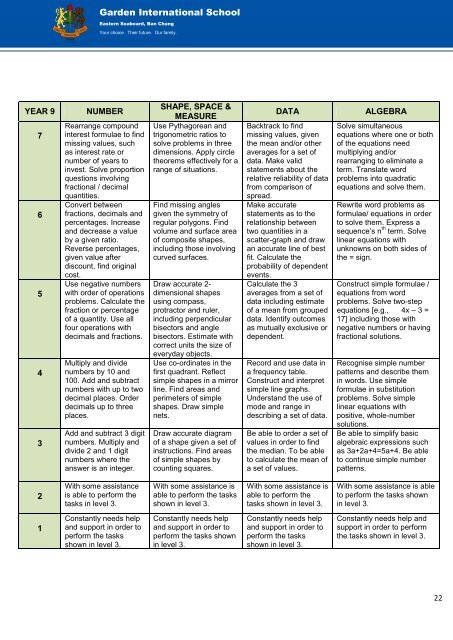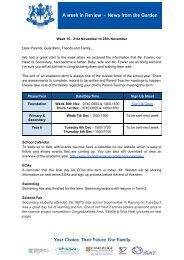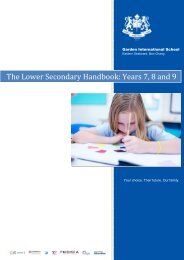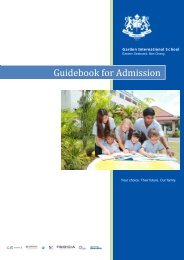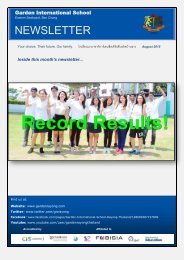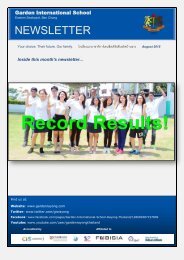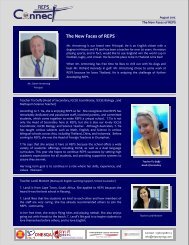Grade Descriptors Years 7 - IB2
You also want an ePaper? Increase the reach of your titles
YUMPU automatically turns print PDFs into web optimized ePapers that Google loves.
Garden International School<br />
Eastern Seaboard, Ban Chang<br />
Your choice. Their future. Our family.<br />
YEAR 9<br />
7<br />
6<br />
5<br />
4<br />
3<br />
NUMBER<br />
Rearrange compound<br />
interest formulae to find<br />
missing values, such<br />
as interest rate or<br />
number of years to<br />
invest. Solve proportion<br />
questions involving<br />
fractional / decimal<br />
quantities.<br />
Convert between<br />
fractions, decimals and<br />
percentages. Increase<br />
and decrease a value<br />
by a given ratio.<br />
Reverse percentages,<br />
given value after<br />
discount, find original<br />
cost.<br />
Use negative numbers<br />
with order of operations<br />
problems. Calculate the<br />
fraction or percentage<br />
of a quantity. Use all<br />
four operations with<br />
decimals and fractions.<br />
Multiply and divide<br />
numbers by 10 and<br />
100. Add and subtract<br />
numbers with up to two<br />
decimal places. Order<br />
decimals up to three<br />
places.<br />
Add and subtract 3 digit<br />
numbers. Multiply and<br />
divide 2 and 1 digit<br />
numbers where the<br />
answer is an integer.<br />
SHAPE, SPACE &<br />
MEASURE<br />
Use Pythagorean and<br />
trigonometric ratios to<br />
solve problems in three<br />
dimensions. Apply circle<br />
theorems effectively for a<br />
range of situations.<br />
Find missing angles<br />
given the symmetry of<br />
regular polygons. Find<br />
volume and surface area<br />
of composite shapes,<br />
including those involving<br />
curved surfaces.<br />
Draw accurate 2-<br />
dimensional shapes<br />
using compass,<br />
protractor and ruler,<br />
including perpendicular<br />
bisectors and angle<br />
bisectors. Estimate with<br />
correct units the size of<br />
everyday objects.<br />
Use co-ordinates in the<br />
first quadrant. Reflect<br />
simple shapes in a mirror<br />
line. Find areas and<br />
perimeters of simple<br />
shapes. Draw simple<br />
nets.<br />
Draw accurate diagram<br />
of a shape given a set of<br />
instructions. Find areas<br />
of simple shapes by<br />
counting squares.<br />
DATA<br />
Backtrack to find<br />
missing values, given<br />
the mean and/or other<br />
averages for a set of<br />
data. Make valid<br />
statements about the<br />
relative reliability of data<br />
from comparison of<br />
spread.<br />
Make accurate<br />
statements as to the<br />
relationship between<br />
two quantities in a<br />
scatter-graph and draw<br />
an accurate line of best<br />
fit. Calculate the<br />
probability of dependent<br />
events.<br />
Calculate the 3<br />
averages from a set of<br />
data including estimate<br />
of a mean from grouped<br />
data. Identify outcomes<br />
as mutually exclusive or<br />
dependent.<br />
Record and use data in<br />
a frequency table.<br />
Construct and interpret<br />
simple line graphs.<br />
Understand the use of<br />
mode and range in<br />
describing a set of data.<br />
Be able to order a set of<br />
values in order to find<br />
the median. To be able<br />
to calculate the mean of<br />
a set of values.<br />
ALGEBRA<br />
Solve simultaneous<br />
equations where one or both<br />
of the equations need<br />
multiplying and/or<br />
rearranging to eliminate a<br />
term. Translate word<br />
problems into quadratic<br />
equations and solve them.<br />
Rewrite word problems as<br />
formulae/ equations in order<br />
to solve them. Express a<br />
sequence‟s n th term. Solve<br />
linear equations with<br />
unknowns on both sides of<br />
the = sign.<br />
Construct simple formulae /<br />
equations from word<br />
problems. Solve two-step<br />
equations [e.g., 4x – 3 =<br />
17] including those with<br />
negative numbers or having<br />
fractional solutions.<br />
Recognise simple number<br />
patterns and describe them<br />
in words. Use simple<br />
formulae in substitution<br />
problems. Solve simple<br />
linear equations with<br />
positive, whole-number<br />
solutions.<br />
Be able to simplify basic<br />
algebraic expressions such<br />
as 3a+2a+4=5a+4. Be able<br />
to continue simple number<br />
patterns.<br />
2<br />
With some assistance<br />
is able to perform the<br />
tasks in level 3.<br />
With some assistance is<br />
able to perform the tasks<br />
shown in level 3.<br />
With some assistance is<br />
able to perform the<br />
tasks shown in level 3.<br />
With some assistance is able<br />
to perform the tasks shown<br />
in level 3.<br />
1<br />
Constantly needs help<br />
and support in order to<br />
perform the tasks<br />
shown in level 3.<br />
Constantly needs help<br />
and support in order to<br />
perform the tasks shown<br />
in level 3.<br />
Constantly needs help<br />
and support in order to<br />
perform the tasks<br />
shown in level 3.<br />
Constantly needs help and<br />
support in order to perform<br />
the tasks shown in level 3.<br />
22


